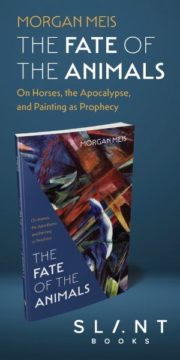 The Fate of the Animals: On Horses, the Apocalypse, and Painting as Prophesy (Three Paintings Trilogy), by Morgan Meis, Slant
The Fate of the Animals: On Horses, the Apocalypse, and Painting as Prophesy (Three Paintings Trilogy), by Morgan Meis, Slant
Review by Leanne Ogasawara
- The discovery of a book of letters written by a soldier and artist to his wife during World War I, and the recognition of this book of letters drives us into a consideration of the Great War, which was a kind of Apocalypse.
In 2011, philosopher and art critic Morgan Meis is wandering the halls of the Museum of Modern Art in New York City. A show on German Expressionism is on, and Meis finds himself transfixed by a certain picture. It is Franz Marc’s 1913 oil, The World Cow. The languid rust-colored creature in the painting calls to mind a cow seen in real life. Recognizing those eyes, Meis recalls its patient stare. Wasn’t there perhaps a hint of rebuke in the cow’s eyes?
This cow becomes the moment of possession. Or perhaps it was more like the first beckoning; for a year or so later Meis stumbles on a book of collected letters that the German painter wrote to his wife whilst a soldier in the Great War. It would be in the war where Franz Marc would lose his life, his skull shattered by a bullet.
Meis is hooked.
Meis’s next stop is Switzerland, where he and his dear friend Abbas Raza—to whom the book is dedicated– stand before Franz Marc’s monumental 1913 The Fate of the Animals, in the Kunstmuseum, Basel. At first glance, he thinks it is a work of early abstract art. With its strong slashes of primary colors, the immediate impression is one of violence. Looking closer, however, the animals come into focus. There is a bluish deer in the lower center, appearing in grave distress. Is the deer being sacrificed? And if so, to what purpose, he wonders. Other animals—including boars and horses—can be just made out among the shafts of color. Is this the end of the world? Read more »
